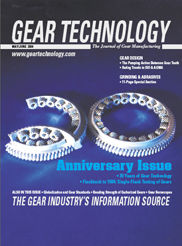This article was originally published 20 years ago, in Gear Technology’s first issue. It describes a method of
evaluating the smoothness, or lack of smoothness, of gear motion. This lack of smoothness of motion, known as
“transmission error,” is responsible for excitation of gear noise and problems of gear accuracy and sometimes has a relationship to gear failure.
